Glamis is set in the broad and fertile lowland valley of Strathmore, near Forfar, county town of Angus, which lies between the Sidlaw Hills to the south and the Grampian Mountains to the north, approximately 20 kilometers (12 mi) inland from the North Sea. The estate surrounding the castle covers more than 57 square kilometres (14,000 acres) and, in addition to parks and gardens, produces several cash crops including lumber and beef. There are two streams running through the estate, one of them the Glamis Burn. An arboretum overlooking Glamis Burn features trees from all over the world, many of them rare and several hundred years old.
In William Shakespeare's play Macbeth (1603–06), the eponymous character resides at Glamis Castle, although the historical King Macbeth (d. 1057) had no connection to the castle.
By 1372 a castle had been built at Glamis, since in that year it was granted by Robert II to Sir John Lyon, Thane of Glamis, husband of the king's daughter. Glamis has remained in the Lyon (later Bowes-Lyon) family since this time. The castle was rebuilt as an L-plan tower house in the early 15th century.
The title Lord Glamis was created in 1445 for Sir Patrick Lyon (1402–1459), grandson of Sir John.
John Lyon, 6th Lord Glamis, married Janet Douglas, daughter of the Master of Angus, at a time when James V was feuding with the Douglases. In December 1528, Janet was accused of treason for bringing supporters of the Earl of Angus to Edinburgh. She was then charged with poisoning her husband, Lord Glamis, who had died on 17 September 1528. Eventually, she was accused of witchcraft, and was burned at the stake at Edinburgh on 17 July 1537. James V subsequently seized Glamis, living there for some time.
John Lyon, 9th Earl of Strathmore and Kinghorne, succeeded in 1753, and in 1767 he married Mary Eleanor Bowes, heiress to a coal-mining fortune.
In 1900, Lady Elizabeth Bowes-Lyon was born, the youngest daughter of Claude Bowes-Lyon, 14th Earl of Strathmore and Kinghorne and his wife, Cecilia (née Cavendish-Bentinck). She spent much of her childhood at Glamis, which was used during the First World War as a military hospital. She was particularly instrumental in organizing the rescue of the castle's contents during a serious fire on 16 September 1916.
On 26 April 1923 she married Prince Albert, Duke of York, second son of George V, at Westminster Abbey. Their second daughter, Princess Margaret, was born at Glamis Castle in 1930.
Since 1987, an illustration of the castle has featured on the reverse side of ten pound notes issued by the Royal Bank of Scotland. Glamis is currently the home of Simon Bowes-Lyon, 19th Earl of Strathmore and Kinghorne, who succeeded to the earldom in 2016.
Glamis Castle
 |
| The Queen Mother Memorial Gates which, since 2008, have stood at the west end of the village of Glamis. |
 |
| King James VI and I |
 |
| King Charles I. |
"The house, from the height of it, the greatness of its mass, the many towers atop, and the spread of its wings, has really a very singular and striking appearance, like nothing I ever saw." ~The poet Gray
 |
| The Main Entrance of Glamis |
flight of steps to the right of the entrance leads down to the dungeons, vaults, and the old well (now filled up) which supplied the inmates with water in times of siege
The vaulted ceiling- is covered in gorgeous stucco plasterwork. The room has a warm color scheme of soft shades of pink and cream.
Paired caryatids flank the heraldic over-mantel, showing Hermes and Aphrodite, their son Hermaphroditos (so called because he so closely resembled both his mother and father.) and his lover Salamaci's. According to legend (from the book "Four Ovids Metamorphose "), the bodies of Hermaphroditos and Salamcis were subsumed together for all time to create both male and female. The coat of arms of James VI of Scotland and I of England lay in the center now painted in heraldic colors. On the left are thistles of Scotland and on the right the rose of England. They intertwine in the center as a symbol of the union of the two crowns in 1603.
Note the two, tiny walnut French chairs placed in front of the fireplace. Those were the favorites of HM The Queen and HRH Princess Margaret when they visited their grandparents at Glamis Castle during their childhood.
Patrick 3rd. Earl of Strathmore - This imposing picture of Patrick 3rd. Earl (1643-1695) and his sons, John, Viscount Glamis later 4th. Earl (1663-1712), Charles Lyon (d. 1692), and Patrick Lyon of Auchterhouse, M.P. (d. 1715) is a masterpiece by the Dutch artist, Jacob de Wet dated 1683. Wearing an impressive Romanesque flesh colored tunic with lion epaulettes, Patrick gestures towards Glamis Castle, which he restored and remodeled in the late 17th. century. Patrick inherited and enormous debt from his father, but his sharp business skills not only helped Glamis Castle to survive but to thrive. His legacy lives on to this day.
 |
| The red chair is reserved for me when I visit Glamis. |
Patrick Lyon, 1st Earl of Kinghorne (c. 1575 – 1615) The portrait of the young Lord Glamis was made in 1583 by Adrian Vanson and still hangs at Glamis Castle.
 |
| Passage from Drawing Room to Chapel |
The Castle Chapel, built in the late 17th century, is an intimate and solemn space. The paintings are of the Life of Christ and were done by the Dutch painter, Jacob de Wet. One notable visitor was James VIII, the ‘Old Chevalier’- part of the Jacobite succession. James was never crowned but was the implied King of Scots. According to Glamis Castle, James ‘conducted a ceremony in the Chapel at which sufferers of the ‘King’s Evil’ (another name for the disease of scrofula, a form of tuberculosis) were presented to the King and “touched”, as it was believed that only rightful Kings could successfully bring about cures’.
The round stained glass window at the rear of the chapel depicts the scene from the book of Revelations where the Archangel Michael and the angels of Heaven defeat Satan (Here depicted as a green dragon.) The window was installed by Heaton, Butler, and Bayne stained glass designers of London in 1870, following the restoration of the chapel by the 13th. Earl in 1866 when it was dedicated to St. Michael and all Angels.
In a more recent times, there is a story that the Queen Mother’s sister, Rose, went into the Chapel to practice playing the organ for the upcoming Sunday service. However, when she entered there was a woman dressed in grey praying in a pew. She waited outside for the woman to finish, but she never came out. Rose eventually peeked into the Chapel only to see that the woman had disappeared. It is believed that it was the ghost of Janet Douglas (the unfortunate soul we discussed earlier), also known as the Grey Lady of Glamis.
 |
| Leaving the Chapel moving to the Billiard Room |
 |
| Moving up and down the stairs one can see the Chapel to the left and the Billiard Room to the right |
 |
| Entrance to the Billiard Room |
 |
| The Billiard Room |
The Billiard-room, with its fine and valuable tapestry, representing incidents in the life of Nebuchadnezzar, and of which only three examples were known to exist, ^ is on this same floor, and is the last of the large rooms, being fifty feet long, but it is not part of the ancient building. Here stands a great chest filled with beautiful costumes in flowered silks, velvets, and satins, as well as old uniforms, all belonging to Lyon ancestors of several centuries ago; besides these a fool's dress remains, cap, bells, and all complete — a rare possession nowadays. Sometimes these ancient garments see the light, when the Castle is full of young and merry guests, who don these slashed and broidered coats and skirts, and when gathered together in the old Crypt almost seem to have forced back the hands of the clock of time two or three hundred years.
 |
| Upon entering the Billiard Room One is at once struck by this beautiful Grand Piano |
This room dates to the late 1700s and was originally the Castle library. Accordingly, one wall consists of numerous volumes of books and are what remains of the once extensive collection. Above the books, are large 17th century tapestries depicting scenes from the life of the Babylonian king Nebuchadnezzar.
The Fireplace
The impressive fireplace was brought from Gibside, one of the seats of the Bowes Family in County Durham. It bears the arms of the Blakistons of Gibside, whose heiress, Elizabeth, daughter of Sir Francis Blakiston 3rd. and last baronet, married Sir William Bowes of Streatlam Castle in 1713.
The 9th. Earl of Strathmore and Kinghorne married their wealthy granddaughter, Mary Eleanor Bowes in 1767.
Until 1722, the basis of the Bowes' influence was their own estate and castle of Streatlam. However from 1713 the acquisition through marriage of the Blakiston estate gave the Bowes family an ever greater influence in the north of the country and a share in the immense wealth obtained from coal trade.
"The Fruit Market" ~ by: Frans Snyders
The huge oil on canvas painting of a fruit market is attributed to the renowned Flemish animal and still -life painter, Frans Snyders. Sir George Bowes purchased it c.1750 and it was formally hung above the dining room fireplace at Streatlam Castle. The prototype is in the Hermitage in St, Petersburg; it is one of a celebrated series of four market scenes which have always been recognized as the artists masterpiece's.
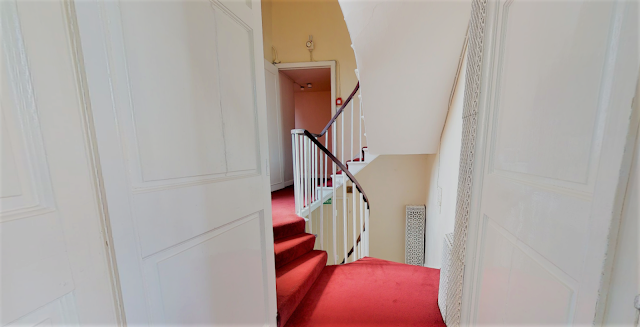 |
| From the Billiard Room we will make our way back to the winding stair |
 |
| Up a few steps to the landing |
 |
| instead of taking the stairs to the right which would lead us back to the Chapel. We will move straight ahead into a dark little passage |
 |
| This dark little passage will take us back to the main Drawing Room |
 |
| Once in the drawing room we will cross to another little door lined in stone. |
 |
| We will take this door toward King Malcom's Room |
Leading off the Drawing room through the stone lined door we enter a little alcove that has some beautiful furniture and porcelain in it.
There is some beautiful inlaid furniture in this little alcove
Little desk made with inlaid wood
Lovely Display case with porcelain
Observe the Porcelain Umbrella Stands on each side of the wash basin
A pair of Japanese porcelain umbrella stands (late Kutani) C. 1870
The staircases which were in use before 1600 are very narrow, dark, and some of them winding, the steps steep and irregular in height, worn into hollows by the many feet that for centuries climbed them. Up two flights of these dimly lit, uneven stairs, the wounded king, Malcolm 11., after having been treacherously attacked and mortally wounded by Kenneth V. and his adherents on the Hunter's Hill, about a mile from the Castle, was carried by his followers to die in the chamber that still bears the name of King Malcolm's Room. This murder of King Malcolm is the first authentic event mentioned by the chroniclers in connection with Glamis.
The Dutch Oak Fireplace
The fine 17th. Century Dutch oak fireplace has an interesting central panel of embossed leather. The arms of the 2nd. Earl above the fireplace have been highlighted in full heraldic colors.
The wall coverings in this room were hand embroidered by the 3rd. Countess of Strathmore.
The Chinese Family Rose Service
The plate is part of one of three armorial Chinese export rose services made for the family in the 18th. century. It is hand-painted porcelain of the Ch'ien Lung/ Quainlong period (1735-95)
One of the three services was given by Patrick the 15th. Earl to his niece Princess Elizabeth in 1947 as a wedding gift for her marriage to Prince Philip. Her Majesty later returned the service to Glamis in an effort to preserve the three services.
Davenport Creamware
Davenport Creamware botanical part dessert service C. 1815 each piece painted with a different named flower.
From the King Malcom Room we make our way into a staired landing. As we move toward the Royal Apartments.
Along the landing we make our way into the Queen's Sitting Room
The Royal Apartments. Countess Cecilia Strathmore converted this part of the castle into private apartments for her daughter and son-in-law, then the Duke and Duchess of York (later King George VI and Queen Elizabeth, Queen Consort).
The Queen Mother's Sitting Room
A secretary in a window alcove made of carved wood
There is a lovely George III mahogany bureau situated near a window in the corner of the room. The Queen Mother would use this to write her private correspondence while at Glamis. The Castle points out that she was ‘a prolific and adept letter writer with a neat hand and many of her letters survive’. If you look carefully at the bureau you might be able to spot the antique telephone hidden behind a picture; that phone had a direct line to Buckingham Palace.
The Queen Mother’s Sitting Room is kept just as it was when the young Elizabeth and her new husband visited for their holidays between 1923 and 1939.
The Carved Oak Chimney Piece
The carved oak chimneypiece has a piece of tapestry with the Madonna and baby Jesus set into the over-mantle, which was cut down from the 17th. century tapestry in the Billiard Room. The upper mantlepiece shows Chinese blanc-de-chine porcelain figurines 19th. -20th. century. on the lower mantlepiece is Chinese, Japanese, and Dutch pieces, including a Chinese Kraak porcelain blue and white dish, painted with birds and flowers amongst rockwork within a border c. 1600; a pair of Japanese Seto porcelain blue and white gourd shaped vases; two pairs of Dutch delft ware plates c. 1700 and c. 1720.
Observe the small fireside chairs used by Princesses Elizabeth and Margaret when visiting the castle.
Flemish Cabinet
The 17th. century style hardwood ormolu-mounted ivory and ebony Italian cabinet is decorated with semi-precious stones, glass ceramics and lapis lazuli. It sits on an ebonized oak chest with boxwood stringling. The drawers and secret spaces of cabinets like this were made to hold precious jewels, scientific instruments, and natural curiosities. The central niche was often made like the interior of a marble palace: a room within a room to inspire private study.
facing back to the door entering the room looking towards King Malcom's Room.
leaving the Queen Mother's Sitting Room through a door leading to her private corridor.





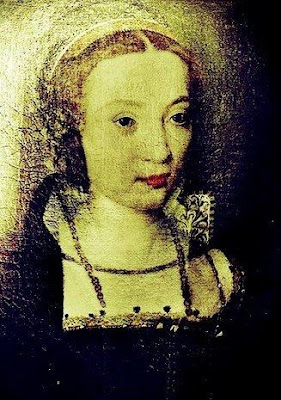


























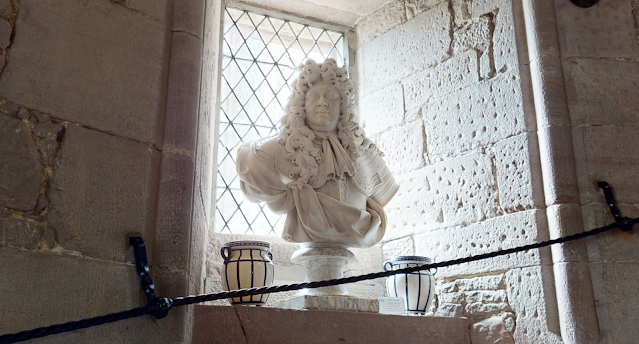



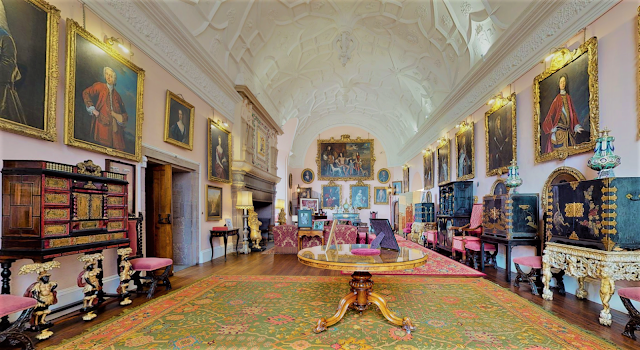













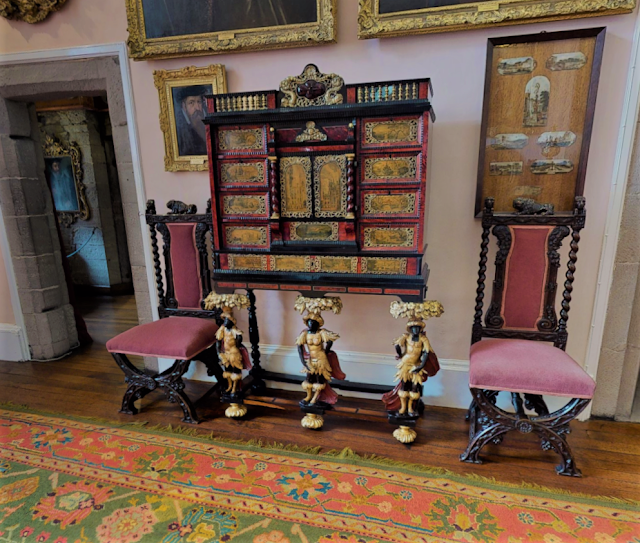























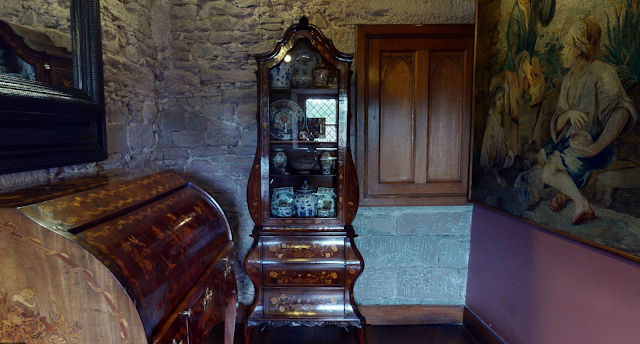





































No comments:
Post a Comment